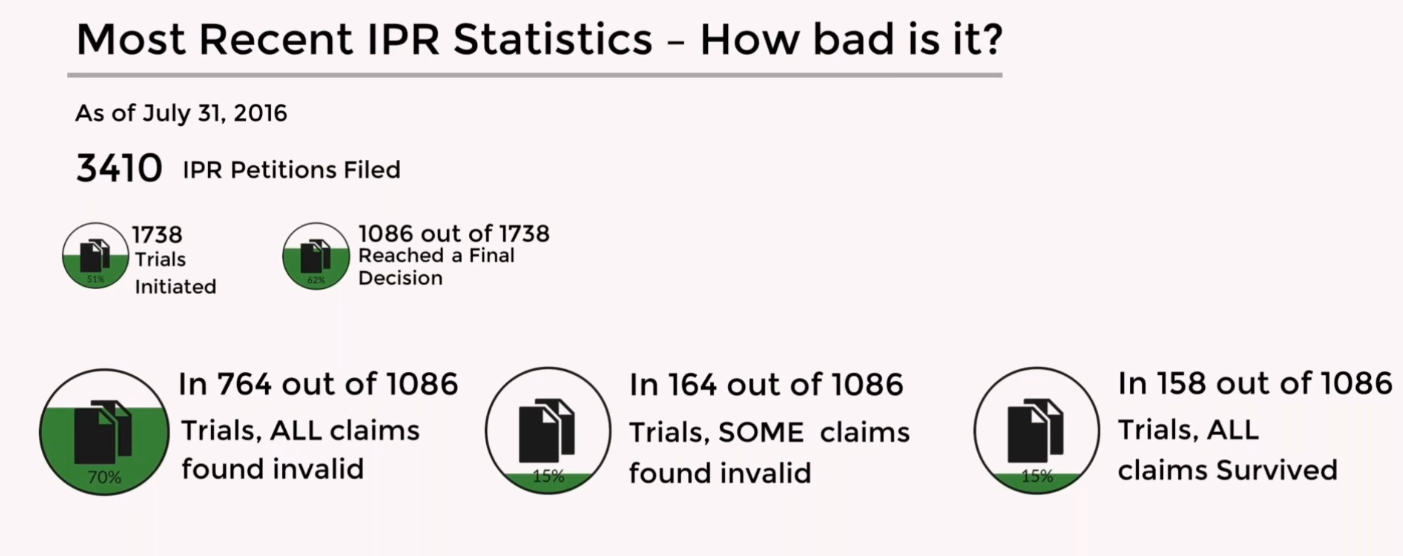A few months ago, there was a post on LinkedIn by a renowned IP strategist expressing her repugnance on the falling quality of patents being drafted by IP attorneys. In her words,
Just had to tell a new client that his prestigious big firm attorney is churning his patent work by filing junk responses in the USPTO. It’s amazing how much nerve some attorneys have about doing meaningless work for their clients when they know no one reading their reporting letters has a clue what they are doing. Also, he’s doing an awful job on the prosecution of a critical patent application, which makes him even more embarrassing as a high-level representative for our profession.
Sadly, this is not a rare case. In the past few years, there has been an exponential growth in low-quality patent filings. Eric Halber, a former Sughrue Mion patent attorney with 25+ years of experience, says that he found 90% of the patent valueless in his first line review. You can read his article in detail here: Click here
Such low-quality patents are of no use to an assignee and add little value to his patent portfolio. The enforcement of a patent depends a lot upon claim construction and patents that have poor claim language are basically useless. How, you may ask?
Why Low-Quality Patents are a Bad Investment?
Consider the situation that an organization has a broad patent on a random field of technology (say Virtual Reality) covering all the key features, but has a poor claim construction. Now imagine that another organization meanwhile develops its own VR headset without any kind of patent protection.
Now, since the first organization has a patent covering the entire technology, it might either sue or initiate licensing discussions with the second organization, in an attempt to leverage the “monetization potential” of its patent.
Instead of reciprocating, the second organization (supposed infringer) might choose to take the matter to the court, in an attempt to escape from paying millions in royalties imposed by the plaintiff.
Looking at the numbers of portfolios that past our first line review, in about 90% of cases we reviewed the patents were valueless. – Eric Halber
Litigation time
This is when the tables turn for the plaintiff. It should be noted here that though our plaintiff had a broad patent covering entire facets of the technology under its scope, the claim construction was done in such a poor manner that the patent, was basically useless (and unenforceable).
During the Markman hearing, the defendant’s attorney would take advantage of this very aspect and prove how the product did not infringe on any of the claims of the plaintiff’s patent. The interesting side note, in this case, is that the defendant’s product did infringe on the plaintiff’s patent. The plaintiff might have been awarded millions in damages; the monetization potential of the patent could have been leveraged- if the claim construction was done well.
Mission “Let’s leverage our Patent”- Fail.
Sadly, the above situation has become an everyday reality. Though some patents end up in a corner eating dust, for their failure to be monetized, the unfortunate ones end up being invalidated too.
That’s right. We live in the AIA era where invalidation is preferred over litigation. It has emerged as a tactic that could save royalty fee which usually runs in millions.
A look at the recent IPR statistics stands as proof to the fact that, even though you got lucky to get a non-patentable subject matter patent granted, if your defendants know their game right, there ain’t a little chance for you to monetize your patents.

Despite spending thousands of dollars to get it granted, a low-quality patent does not even fetch pennies. The truth of the day is– a low-quality patent is not an asset, but rather a liability.
No one likes liabilities.
That gets us to the question– who is responsible for these not-an-asset-but-a-liability patents in your portfolio?
Who is responsible for a low-quality patent?
Who should be blamed here?
- The plaintiff,
- The attorney handling the litigation or
- The counsel who drafted the patent application with poor claim language such that the thousands of dollars spent on it didn’t fetch pennies.
Who is responsible for the bad patents?
Many amongst us (Eric Sutton included) would be of the opinion that counsel drafting claims are responsible for bad quality patents. It stands to reason that when you have an invention with an immense monetization potential and you are the first to file in the AIA era, and still fail to make money out of your patent– the claim drafting counsel is at fault.
But one fact that often goes unnoticed is that the counsels alone are not responsible for the slip in quality. There exists a latent reason behind the reduced quality of patent applications.
Care to know it?
It’s the system!
The system that puts pressure to increase patent filings every year and at a reduced cost.
How The Pressure to File a lot of Patents Lead to Low-Quality Patents
In the name of patent strategy, organizations try to get a patent over every possible thing that has ever been invented in an attempt to make the maximum out of the investment on the R&D.
With such an ongoing zeal, the patent attorneys or in-house counsels face the pressure to file a lot of patents, that too, under extremely low budget.
Moreover, in a lot of corporations, the management adds the number of patents filed every year as one of the key performance indicator (KPI) for the IP counsels. In an attempt to achieve their target and outrace their peers, quality is often undermined leading to bad patents.
We believe it’s not the fault of the IP Counsels. It is the fault of the management for failing to understand the difference between quantity and quality.
Further, due to cost constraints, the absence of a patentability search clears the path for the bad patent applications to reach to the USPTO and if lucky also get granted costing $20-25K to the company with a zero return in future.
That’s what a bad patent worth.
Zero.
How Could Low-Quality Patent Filing be Avoided?
There are two suggestions which if adopted could prevent future occurrences of such low-quality patents:
- KPI of the IP Counsels should change from numbers of patents filed to numbers of star patents filed every year. Such KPIs would not just ensure high-quality patents which could be very useful for defensive strategy but would also bring in revenue for the company.
- Approve budget for patentability searches. These searches cost a fraction of the total cost of a patent, but can end up saving $100k+ in drafting/filing/maintenance costs, making sure that the applications filed are indeed patentable subject matter, which could be monetized without the fear of being invalidated.
It is also often noted that some IP attorneys keep a close track of bad patents and discard them regularly in order to increase the value of a patent portfolio.
At times, patents are discarded if they aren’t in sync with business/patent strategy of an organization. Having a portfolio in-sync with the business strategy of your organization is paramount. However, if it happens frequently in your organization, it’s time to change the system.
Conclusion
A little tweak in the system can change a lot of things. Small changes applied to the system every now and then will ensure that the portfolio is indeed worth more than what it appears to be.
Now that you know what to change in your organization, go and change something today. Life will be a lot better.
Authored by: Anjali Chopra, Research Analyst











